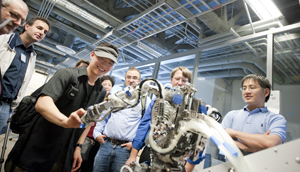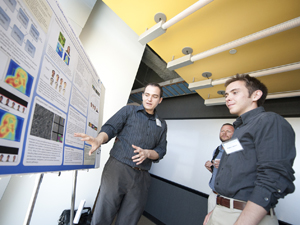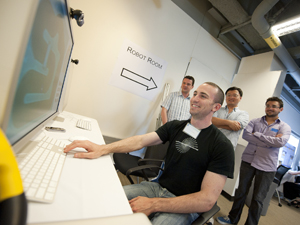Temporal Dynamics of Learning Center Looks to the Future
By Tiffany Fox, (858) 246-0353, tfox@ucsd.edu
San Diego, Calif., Aug. 3, 2010 — Now in its fifth year, the Temporal Dynamics of Learning Center (TDLC) is looking forward to what it hopes will be a second lease on life if the National Science Foundation (NSF) renews funding for five more years, at $4 million per year. A NSF review board recently visited TDLC’s home base at the University of California, San Diego, to meet with researchers from all 10 participating universities and determine the future of the Center.
|
TDLC is a Science of Learning Center, one of six funded by NSF. The center’s purpose is to understand the role of time and timing in learning, and how to apply this understanding to improve the way students are educated.
"The goal of the TDLC is to study how timing affects learning from the synapse to the classroom," explained Executive Director and Principal Investigator Garrison Cottrell during his opening remarks on the first day of the NSF review. "The idea is to improve our understanding of learning using basic science so we can improve teaching practices."
Across its member campuses, the TDLC is comprised of 40 principal investigators and 50 projects. Three TDLC researchers are based at the UC San Diego division of the California Institute for Telecommunications and Information Technology (Calit2), and work on a number of projects takes place at Calit2, including the Center’s robot projects and research in expression recognition. Calit2 also hosted the demo and poster session during the site visit.
TDLC’s research addresses four key questions: 1) How is temporal information about the world learned and how does the temporal dynamics of the world influence learning? 2) What are the temporal dynamics of brain cells, brain systems and behavior, and how do these cells change with learning? 3) What are the temporal dynamics of motor control and information seeking, and how are they learned? and 4) What are the general principles that explain the dynamics of learning across multiple scales and domains?
|
“The NSF review was an opportunity to demonstrate that we are more than the sum of our parts,” remarked Marian Stewart Bartlett, an associate research professor at UCSD’s Institute for Neural Computation and co-director of UCSD’s Machine Perception (MP) Laboratory (MPLab), based at Calit2. “Many important collaborations have come about as a result of this center, and one thing that has been measured is that major scientific breakthroughs most often take place in multidisciplinary groups. It is always important to connect people who may not have been connected before."
A panel of about 15 site reviewers, including well-established researchers in key areas such as cognitive science, robotics, computational neuroscience and education, spent three days at UC San Diego listening to presentations by TDLC scientists, reading research posters and seeing demonstrations of technologies developed in TDLC-affiliated groups such as MPLab. The technologies on display were the Center's Einstein Robot Head, which recognizes a number of human facial expressions and can respond accordingly; an educational robot named RUBI, which was designed by MPLab to interact with pre-school children; and Diego, a robot designed to mimic a one-year-old human baby.
The panel also heard testimonials from TDLC-affiliated researchers about the importance of their collaborations, which, they say, would have been less likely were the investigators funded independently.
|
"The TDLC has created a network of research networks in sensorimotor learning, interactive memory systems, perceptual expertise, and social interaction," noted Cottrell., a professor of computer science and engineering in UCSD’s Jacobs School of Engineering. "This structure organizes our scientists into smaller, interdisciplinary research communities that become the engines of TDLC’s research.
"The research structure we have works," he added. "When you share techniques, vocabulary, and intellectual problems, collaboration is easier. This is a great opportunity for our trainees, as they become familiar with researchers from many disciplines who are willing to give them guidance on their projects. As one of our students once put it, ‘It takes a network to raise a graduate student.’”
CERT, or Computer Expression Recognition Toolbox, is a signature MPLab project that has fostered multiple collaborations, spin-off projects and even consumer technologies. A software package for automatically detecting facial expressions, CERT contains "smile detection" technology that allows a “teaching robot” like RUBI to notice when a child is smiling – and therefore carry on with her lesson (if the child is frowning in confusion, RUBI might take a step back and review the lesson). This smile detection technology was created using machine learning techniques, trained upon a dataset of more than 60,000 individuals.
|
"The take-home message," said Cottrell, "is that technological advances have spread through the TDLC, spawning new research directions and potential. Our goals are being well-served by our projects."
The next step for TDLC members will be to respond to the NSF’s Site Visit Report, which was delivered in mid-July. The final determination concerning the Center's funding will come in February of 2011. If funded, TDLC plans to continue to engage in a number of collaborative projects, including research into the role of music and rhythmicity, and how they relate to brain rhythms associated with readiness for learning.
Media Contacts
Tiffany Fox, (858) 246-0353, tfox@ucsd.edu
Related Links





